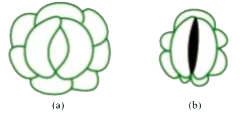Guard cells :
a. Enclose stomatal pore
b. Are dumb - bell shaped in dicots
c. Outer wall thick and inner wall thin
d. Regulates opening and closing of stomata
a & b are correct
a & d are incorrect
b & c are incorrect
c & d are correct
The correct Answer is:3
To analyze the statements regarding guard cells, we will evaluate each statement one by one based on the information provided in the video transcript.
1. Statement A: Enclose stomatal pore
- Evaluation: Guard cells indeed enclose the stomatal pore, which is the opening that allows gas exchange in plants.
- Conclusion: This statement is correct.
2. Statement B: Are dumb-bell shaped in dicots
- Evaluation: The transcript states that guard cells in dicots are bean-shaped, while in monocots, they are dumbbell-shaped.
- Conclusion: This statement is incorrect.
3. Statement C: Outer wall thick and inner wall thin
- Evaluation: According to the transcript, the outer wall of guard cells is thin, and the inner wall is thickened.
- Conclusion: This statement is incorrect.
4. Statement D: Regulates opening and closing of stomata
- Evaluation: The transcript confirms that guard cells are responsible for regulating the opening and closing of stomata.
- Conclusion: This statement is correct.
Summary of Evaluations:
- Statement A: Correct
- Statement B: Incorrect
- Statement C: Incorrect
- Statement D: Correct
Final Conclusion:
The correct statements are A and D, while B and C are incorrect. Therefore, the correct answer is that B and C are incorrect.
- Evaluation: Guard cells indeed enclose the stomatal pore, which is the opening that allows gas exchange in plants.
- Conclusion: This statement is correct.
- Evaluation: The transcript states that guard cells in dicots are bean-shaped, while in monocots, they are dumbbell-shaped.
- Conclusion: This statement is incorrect.
- Evaluation: According to the transcript, the outer wall of guard cells is thin, and the inner wall is thickened.
- Conclusion: This statement is incorrect.
- Evaluation: The transcript confirms that guard cells are responsible for regulating the opening and closing of stomata.
- Conclusion: This statement is correct.
- Statement A: Correct
- Statement B: Incorrect
- Statement C: Incorrect
- Statement D: Correct
The correct statements are A and D, while B and C are incorrect. Therefore, the correct answer is that B and C are incorrect.
Similar Questions
Knowledge Check
- Question 1 - Select One
Assertion: Each stomata is composed of two bean shaped cells known as guard cells.
Reason: Guard cells regulate the opening and closing of stomata.AIf both assertion and reason are true and reason is the correct explanation of assertionBif both assertion and reason are true but reason is not the correct explanation of assertion.Cif assertion is true but reason is false.Dif both assertion and reason are false. - Question 2 - Select One
Which statements are correct about guard cells?
I.They are modified group tissues
II.They are chlorophyllous
III.Its outer wall is thin and inner wall is highly thickened
IV.They regulates stomatal movement for transpiration and gaseous exchangeAAll except IBall except IICall except IIIDall except Iv - Question 3 - Select One
When turgidity increases within the two guard cells flanking each stomatal aperture or pore, the thin outer walls and force the inner walls into a shape.
Abulge in, crescentBbulge out, crescentCbulge out, spindleDbulge in, spindle
How do the guard cells regulate opening and closing of stomatai pores?
View SolutionHow do the guard cells regulate opening and closing of stomatal pores ?
View SolutionObserve the diagram and answer the following :

(a) Which of these guard cells show a higher water content, A or B ?
(b)Are these types of guard cells found in monocots or dicots ?
(c) Name the element which play an important role in the opening and closing of stomata.View SolutionMatch column I with column II and select the correct option from the given codes.
Column IColumn IIA. Bulliform cells(i). Regulate opening and closing of stomataB. Guard cells(ii). Aerating pores in the bark of plantC. Lenticels(iii). Rolling in and out leavesD. Subsidiary cells(iv). Accessory cellsView Solution(a) Name the plants in which the guard cells of stomata are dumb-bell shaped.
(b) What are the constituents of stomatal apparatus ?
(c) What is the function of trichomes in the shoot system?View Solution

